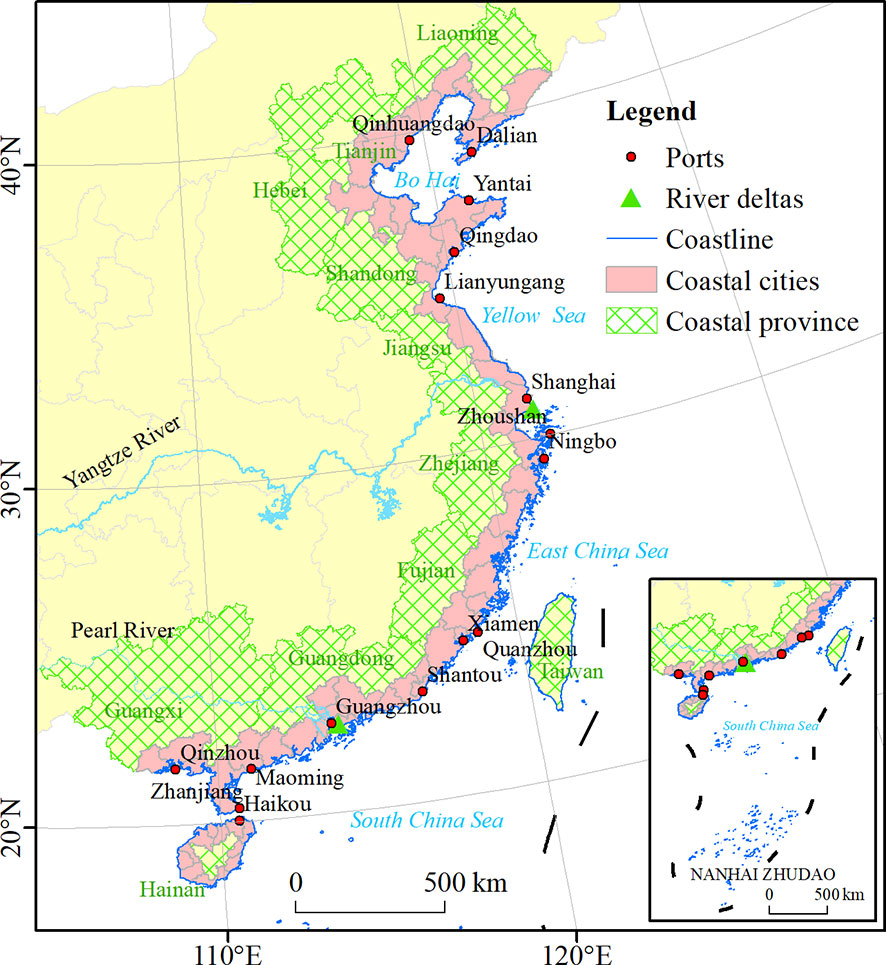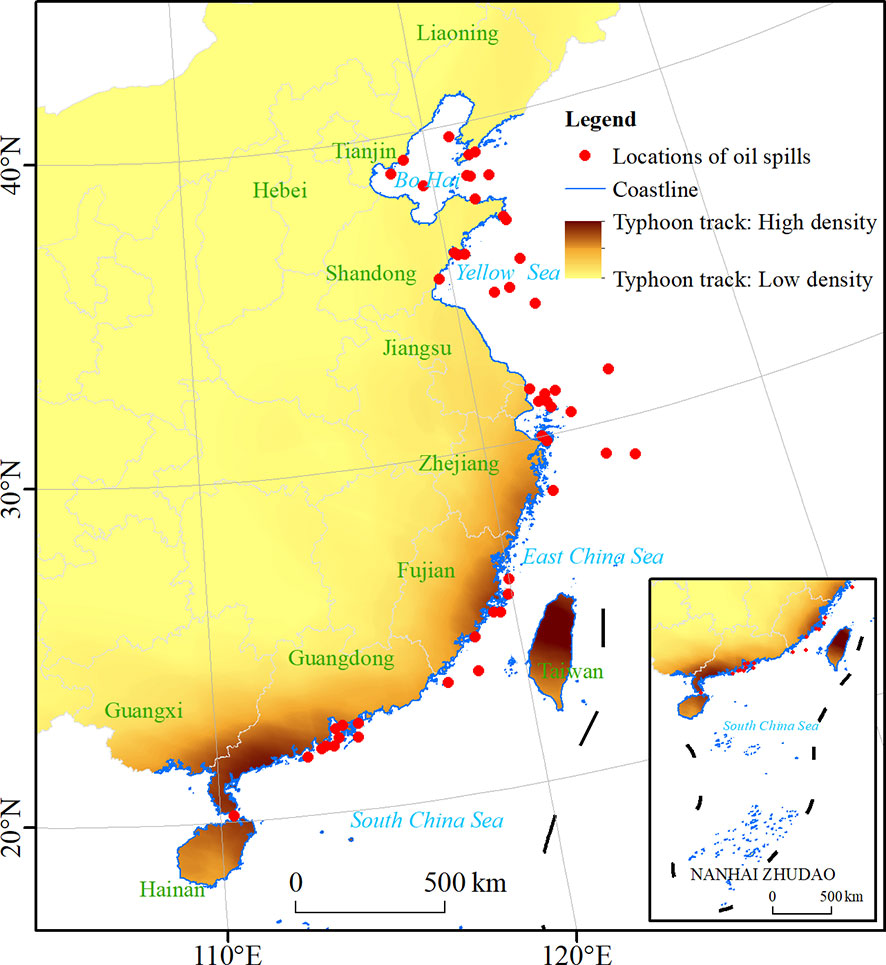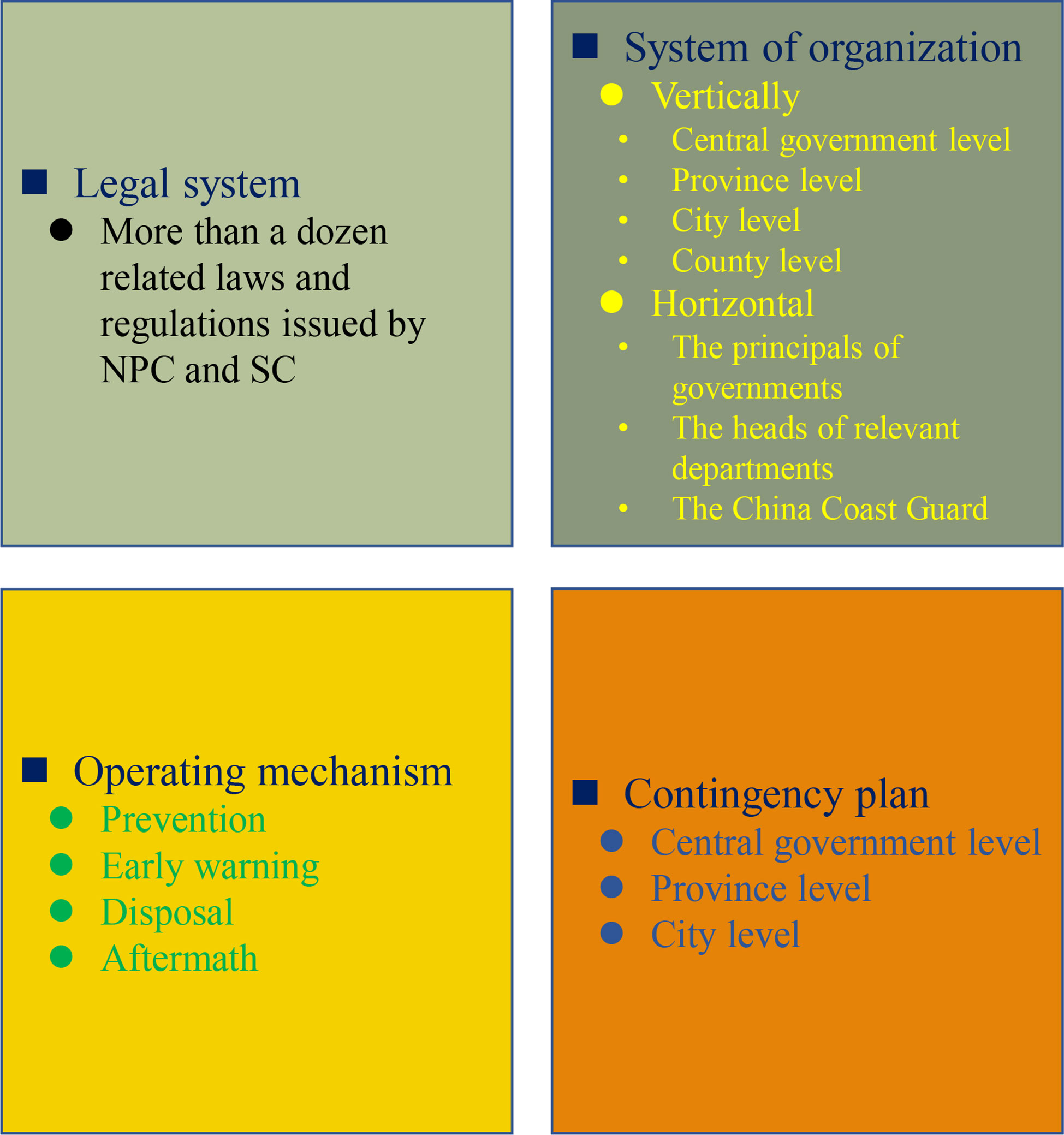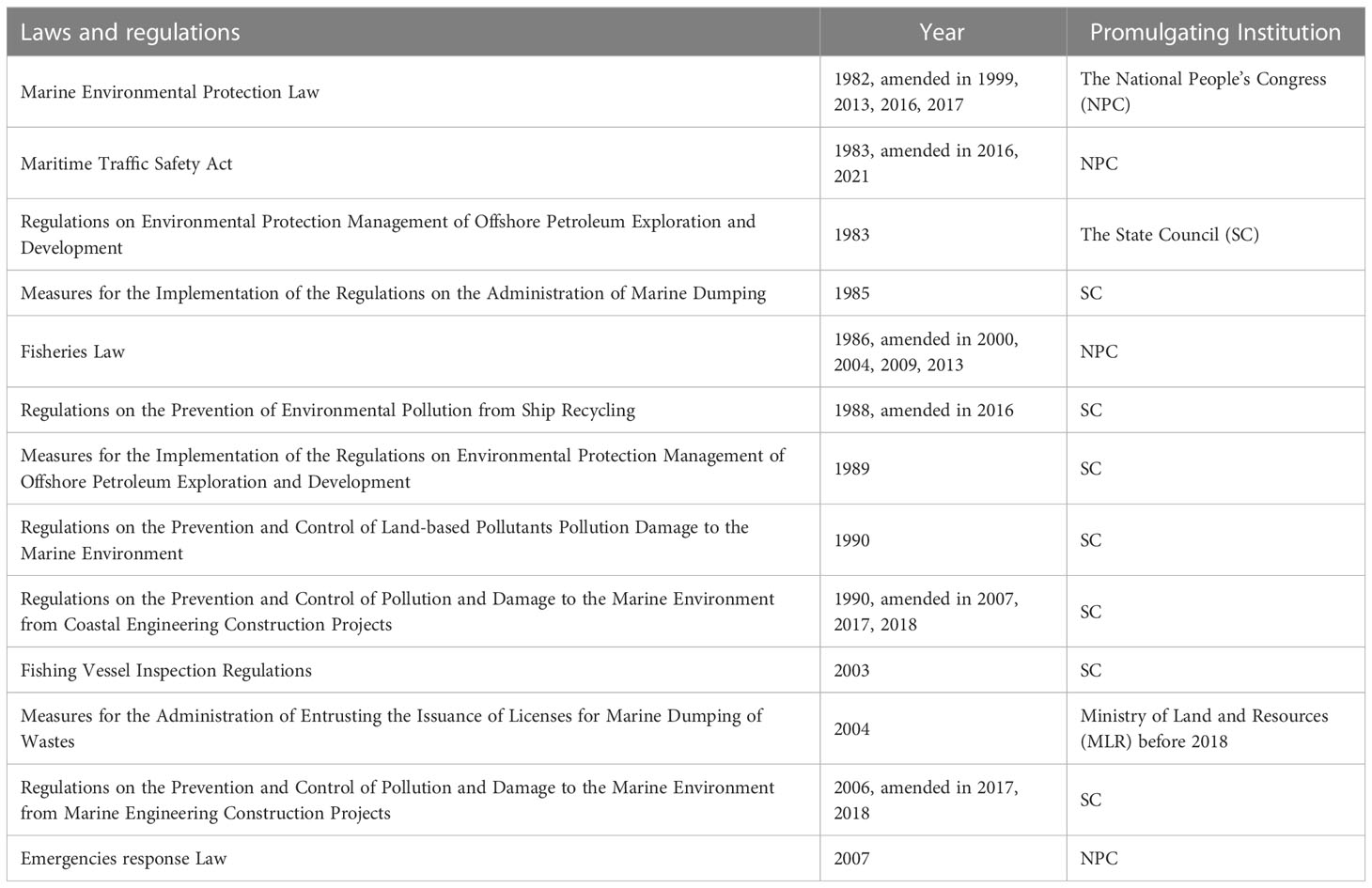- 1School of Ocean, Yantai University, Yantai, China
- 2Yantai Engineering & Technology College, Yantai, China
- 3University of Chinese Academy of Sciences, Beijing, China
Understanding the risk characteristics of marine disasters is of great importance for disaster prevention and mitigation. In this study, we considered four types of marine disasters typical in China, including storm surges, rough seas, harmful algal blooms, and oil spills to identify risk characteristics. Disaster risk was analyzed based on the theory that the marine disaster risk consists of hazard, exposure, and vulnerability. These three factors have been analyzed based on statistical data from a collection of historical documents and official records. The following characteristics were identified. First, the occurrence frequency of storm surges and rough waves has remained stable over the past few decades, but the occurrence frequency of red tides and oil spills has shown a downward trend. Second, storm surges were found to be the main cause of economic losses, while rough seas were the main cause of death. Economic losses and fatalities have shown a downward trend against the backdrop of a growing economy and population. Third, there are clear regional differences in the spatial distribution of all disasters, so it is necessary to formulate disaster prevention and mitigation plans according to the spatial differentiation of risks. Based on the various disaster prevention and mitigation measures taken by the government, this study makes some recommendations for future actions that the government should take from the perspective of risk composition. The risk analysis paradigm for marine disasters provided in this study is expected to be used for future marine disaster prevention and mitigation.
1 Introduction
Disasters pose a significant challenge to economic development and social security all over the world. Disaster management is considered to be an important part of responding effectively to disasters (Baker and Refsgaard, 2007; Vanderhorst et al., 2021). Some disasters, such as storm surges, have become more frequent and severe, especially in the context of climate change (Leal et al., 2022); hence, effective disaster management has become increasingly important (Mall et al., 2019).
Disaster management consists of four distinct phases, which are mitigation, preparedness, response, and recovery (Yu et al., 2018). Disaster risk analysis and assessment are the foundation for disaster management and provide important information for each of the four phases, especially for disaster decision-making (Gong and Forrest, 2014).
Coastal zones are five times more vulnerable to disasters than inland areas (Haran, 2020). Therefore, marine disasters are of greater concern than land disasters. China has more than 18,000 kilometers of continental coastline, 7372 islands over 500 square meters in area, and nearly 3 million square kilometers of sea areas. Historically, these areas have suffered from frequent marine disasters (Wang, 2020). For this reason, marine disasters have received substantial attention in China (Zhao et al., 2020).
A number of scholars have focused on disaster risks analysis, risk reduction, and risk management framework (Chen et al., 2020; Ekstrom et al., 2020; Trotta et al., 2021; Liu, 2022). An accurate understanding of disaster risk characteristics is necessary for building an effective risk management framework. Since the State Oceanic Administration (SOA) started issuing Marine Disaster Bulletins (MDB) in April 1990, first-hand information on mainland China’s marine disasters have been officially and systematically recorded. These data, combined with other statistical data, provide an opportunity to study marine disaster risk characteristics in China.
Analyzing the risk characteristics of these disasters is important for systematic analysis of the characteristics of China’s marine disaster risk. Generally, disasters can be categorized based on temporal scales into rapid-onset hazards and slow-onset hazards (Gill and Malamud, 2014). Rapid-onset disasters includes storm surges, rough seas, red tides, green tides, and oil spills, which have temporal scales of hours, days, and months. Slow-onset disasters include coastal erosion, seawater intrusion, coastal soil salinization, and sea level rise, which have temporal scales of more than three months (Fang et al., 2017). All of these disasters have had adverse effects on economic and social development. However, for slow-onset disasters, there is a lack of detailed information or records about their effects, possibly because they do not result in immediate visible economic losses and fatalities and thus fail to attract the attention of government entities.
Worldwide, a great deal of research has been conducted on marine risk management (Ouyang, 2020; Rangel-Buitrago et al., 2020). Most of these studies select a specific disaster for in-depth analysis, but seldom examine their risks from the perspective of three independent determinants: hazard, exposure, and vulnerability. Hence, in order to fully understand the risk characteristics of China’s marine disasters, this study focused on the storm surges, rough seas, harmful algal blooms (including red tides and Ulva prolifera (U. Prolifera) green tides), and oil spills by considering the hazard, exposure, and vulnerability of marine disasters in China. These disasters are considered to be the most typical disasters in China and have the most detailed records. The objectives of this study were to analyze the risk characteristics of marine disasters in China, discuss the status quo regarding China’s marine disaster risk, and provide useful information for improving China’s marine disaster management. The rest of this paper is structured as follows. Section 2 provides the detailed data sources and describes the data processing. Section 3 analyzes the risk characteristics from the perspective of hazard, exposure, and vulnerability, as well as the disaster temporal and spatial characteristics. Section 4 reviews China’s management of marine disasters, as well as China’s marine disaster-related legal system, system of organization, operating mechanism, and emergency response plans. Section 5 discusses the future opportunities of China’s marine disaster management.
2 Data and methods
2.1 Risk analysis method
This study analyzed the risk composition of China’s marine disasters from the perspective of hazard, exposure, and vulnerability, as shown in formula (1). In addition, understanding disaster risk requires us to not only consider hazard, exposure, and vulnerability, but also to consider the society’s capacity to protect itself from disasters. Therefore, disaster coping capability (resilience) is also an important part of disaster risk analysis.
2.2 Study area
This study focused on the coastal zone and offshore areas of mainland China. A total of 52 coastal cities contributed data on economy and population values for the risk analysis. For ease of description, all locations used in this study have been marked on a map (Figure 1), and the distribution of offshore waters is as follows: China’s offshore waters from north to south are the Bohai Sea, the Yellow Sea, the East China Sea, and the South China Sea.
2.3 Data sources and processing
To analyze the risk characteristics of marine disasters in China, official government statistical data were collected from the sources listed below.
● Marine Disaster Bulletin (MDB)
● Bulletin of Marine Ecological Environment Status in China (BMEES)
● Marine Environment Quality Bulletin (MEQB)
● Statistical Bulletin of China’s Marine Economy (SBCME)
● China Urban Statistical Yearbook (CUSY)
● China Statistical Yearbook (CSY)
We focused on hazard, exposure, and vulnerability and used data from a series of records that were issued to the public annually to provide the official statistical information (Table 1).
(1) Hazard: The hazard associated with disasters is usually expressed in terms of the disaster’s intensity, occurrence frequency, and duration (Zhang, 2004). MDBs do not contain much detail on the intensity and duration of storm surges, rough seas, harmful algal blooms (red tides and U. Prolifera green tides), and oil spills, but do contain a detail about their frequencies.
(2) Exposure: Exposure changes over time and from place to place and is different for different disasters. Despite this, all disasters will eventually affect human society. In this paper, exposure is represented by the marine-related gross domestic product, marine-related value added by industry, GDP of coastal cities, and resident population of coastal cities.
(3) Vulnerability: The vulnerability of the environment reflects the susceptibility of society to marine disasters. Therefore, economic and infrastructure losses caused by various disasters were used to measure vulnerability.
(4) Resilience: The ability to prevent disasters reflects the ability of emergency departments and the masses to prepare for disasters beforehand and respond during disasters. Not all marine disaster prevention and mitigation capabilities are clearly documented, so this study obtained relevant data from published studies.
To eliminate the differences in economic statistical data caused by inflation and facilitate the comparison of economic data in different years, since 2000, the consumer price index (CPI) is used to convert the economic data to the recalculated values as follows:
where GDPi−2021 represents the recalculated GDP values for year i based on 2021, GDPi represents the published GDP value of year i by CSY, CPI2021 represents the CPI index based on 2021, and CPIi represents the published CPI value of year i by CSY.
3 Risk characteristic analysis
3.1 Hazard
MDBs lack frequency data for rough seas for 2000 and 2001, so its statistics begin in 2002. It can be seen from Figure 2A that since the beginning of the 21st century, the frequency of storm surges and rough seas has been relatively stable.
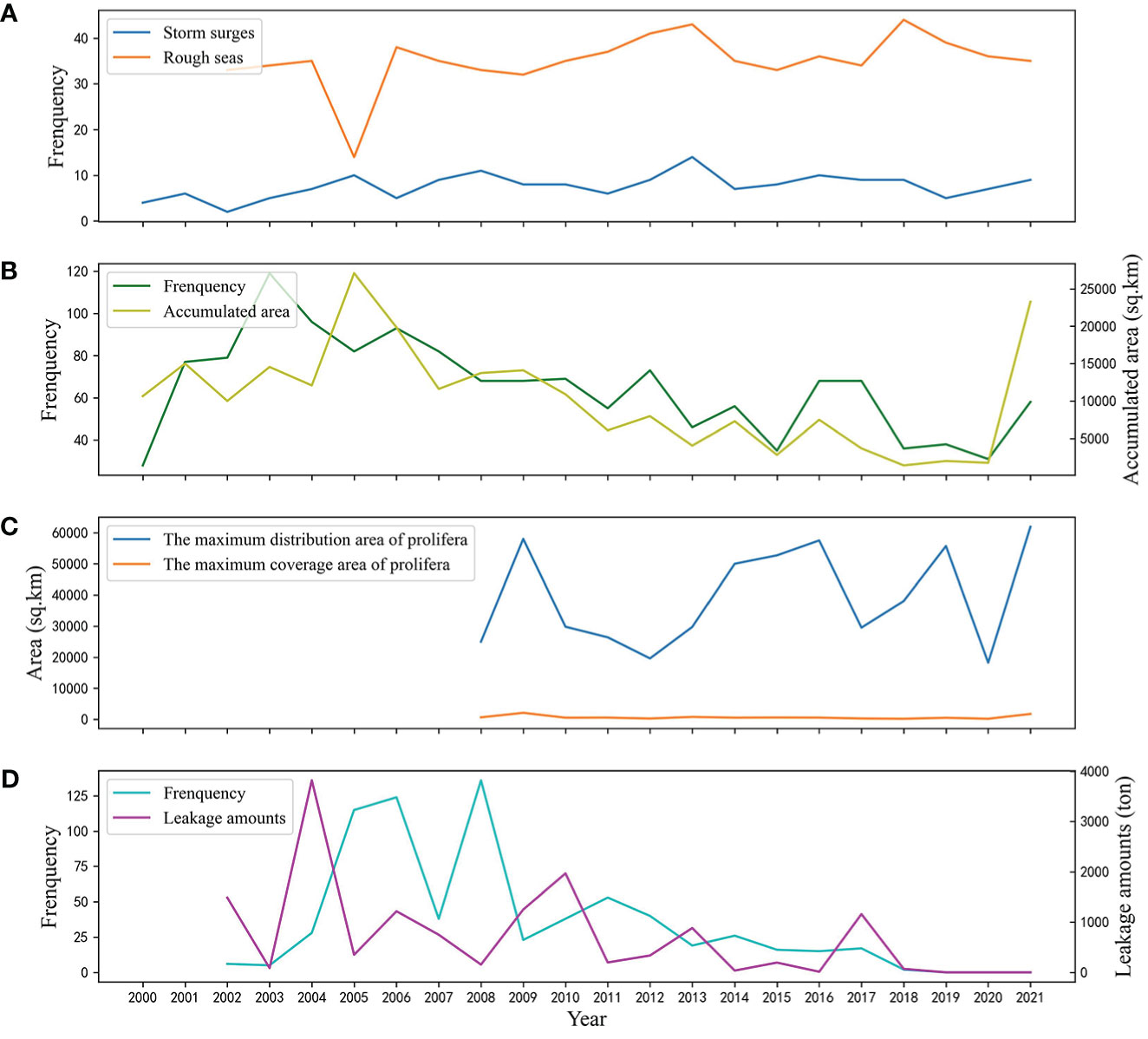
Figure 2 (A) Frequency of storm surges and rough seas (B) Frequency and accumulative area of red tides (C) The maximum distribution area and maximum coverage area of U. Prolifera (D) Frequency and leakage amounts of oil spills.
The data show that 1,425 red tides occurred in China’s coastal areas from 2000 to 2021. The frequency and cumulative area of red tides shows an initial increase followed by a decrease (Figure 2B). The frequency of red tides peaked at 119 in 2003 and the cumulative area peaked at 27,070 km2 in 2005. Except for 2021, the frequency and cumulative area showed a downward trend.
Compared with other disasters, U. Prolifera occurred relatively late. It first occurred in 2007 and has re-occurred frequently in the Yellow Sea waters of China since then. Over the years, its maximum coverage area has been relatively stable (annual average of 679 km2), but the maximum distribution area fluctuates substantially compared with annual average of 3724 km2 (Figure 2C).
The data on oil spills are missing statistics for 2000 and 2001. Based on available records, the number of oil spills and the amount of oil spilled both show an overall downward trend (Figure 2D). Oil spills peaked at 3,817 tons in 2004 and the number of oil spills peaked at 136 in 2008.
3.2 Exposure
Figure 3 shows that, since 2000, the resident population and GDP of China’s coastal cities have shown a trend of continuous growth. The resident population has increased from 0.23 billion in 2000 to more than 0.3 billion in 2020, and the GDP increased from 5434 billion Chinese yuan (CNY) in 2000 to 36101 billion CNY in 2021. Of particular concern is the economic data related to the marine industry. Marine-related gross domestic product has grown from 661 billion CNY in 2000 to 9,039 billion CNY in 2021, and the marine-related value added of industry has grown from 367 billion CNY in 2000 to 5949 billion CNY in 2021.
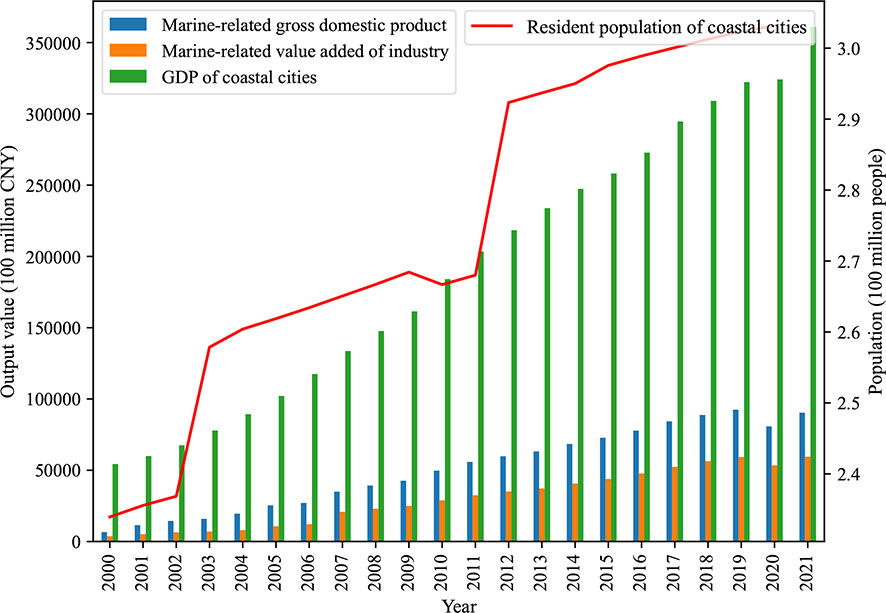
Figure 3 Marine-related gross domestic product, marine-related value added of industry, GDP of coastal cities, resident population of coastal cities.
3.3 Vulnerability
Disaster vulnerability can be represented by the degree of loss after a disaster. The greater the disaster-associated losses, the higher the vulnerability. A low degree of loss means low vulnerability (Huang et al., 2019). From 2000 to 2021, marine disasters caused a total loss of 321.2 billion CNY in mainland China, and caused up to 2,805 deaths. Most economic losses were caused by storm surges (295.4 billion CNY). Economic losses caused by rough seas and red tide were 5.91 and 5.03 billion CNY respectively, and losses caused by U. Prolifera and oil spills are only sporadically recorded in individual years, so they are not shown in Figure 4. The vast majority of fatalities (including disappearances) were caused by storm surges (1,908 fatalities) and rough seas (888 fatalities). Very few deaths or disappearances were caused by other disasters. Swells killed eight people in 2011 and oil spills killed one person in 2000. Red tides and U. Prolifera did not cause deaths or disappearances, so Figure 4A does not show a death toll curve for red tide, U. Prolifera, and oil spills. Both economic losses and deaths showed an overall downward trend during the study period. Economic losses during 2011 and 2021 (102.5 billion CNY) were less than that during 2000 and 2010 (218.8 billion CNY), a 53% reduction. The decline in the number of deaths is more pronounced than the decline in economic losses. Fatalities from 2011 to 2021 (total 525 people) were less than that from 2000 to 2010 (total 2280 people), a 77% reduction.
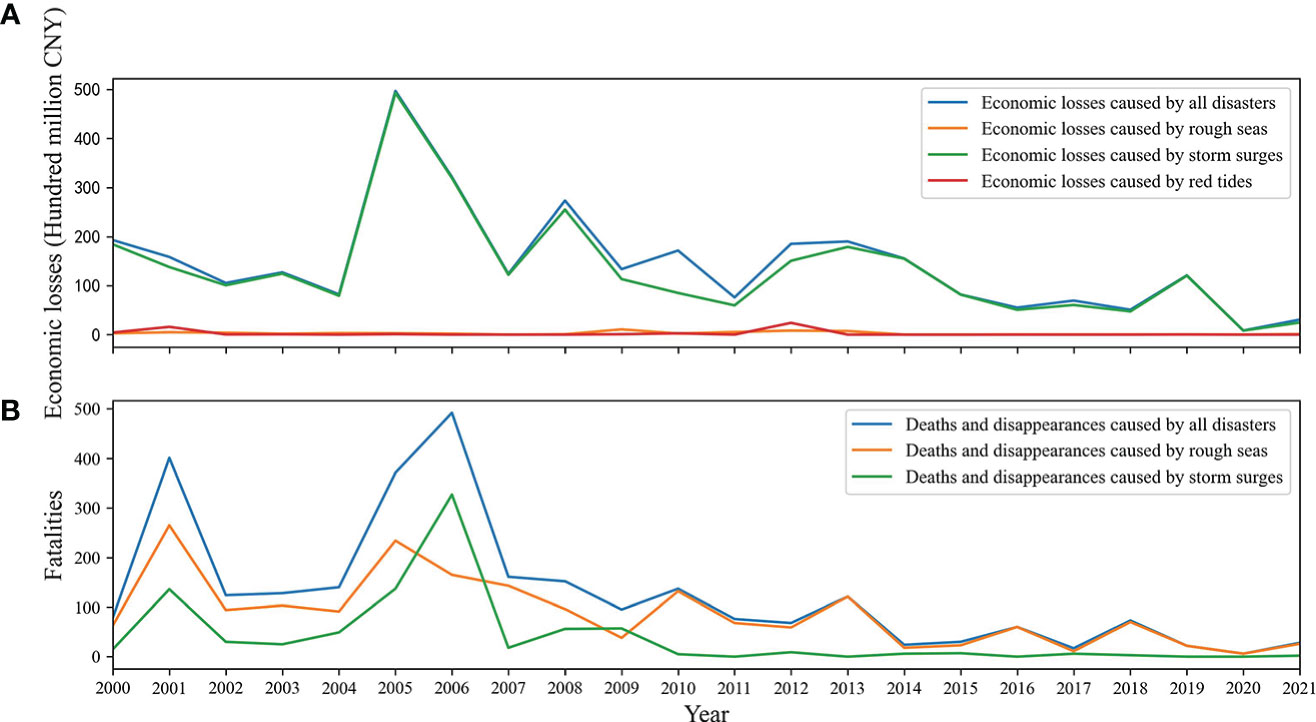
Figure 4 (A) Economic loss caused by various disasters. (B) Population losses caused by various disasters.
3.4 Disaster temporal characteristics
Over the past 22 years, the occurrence frequency of storm surge and rough seas has remained stable. In contrast, economic losses and fatalities have shown a downward trend against a backdrop of a continuously growing economy and population. This phenomenon is consistent with previous research (Liu et al., 2019), which determined that coastal engineering is considered an effective way to reduce losses. In other words, the decline in economic losses and fatalities is a result of the engineered disaster prevention and mitigation measures in coastal zones, which have achieved remarkable results.
The frequency of red tides and oil spills showed a downward trend over the study period. The cumulative area of red tides and leakage amounts of oil spills also showed a downward trend.
The maximum coverage area of U. Prolifera remained stable, although the maximum distribution area fluctuated greatly from year to year. Despite extensive research, the mechanisms behind U. Prolifera outbreaks are not well understood (Zhang et al., 2019). Therefore, it is difficult to explain the reasons for tits area fluctuations.
Storm surges caused the heaviest direct economic losses, accounting for 92% of the total direct economic losses. Wave disasters caused the greatest number of deaths and disappearances, accounting for 68% of the total.
3.5 Disaster spatial characteristics
The coastal zones along the Bohai Sea and the northern Yellow Sea are under the threat of extra-tropical induced storm surges (ETSSs), while the coastal zones along the southern Yellow Sea, the East China Sea, and the South China Sea are under the threat of typhoon-induced storm surges (TSSs) (Wang et al., 2021). Figure 5 shows how typhoons travel from the sea to the land, affecting mainly coastal areas in southeast China. In contrast, rough seas occur in all sea areas, so there are no obvious spatial characteristics.
MDBs records include only a general description of the location of red tides and U. Prolifera outbreaks. There are no exact coordinates recorded, so it is difficult to visually represent them on the map. We can describe their distribution only qualitatively. U. Prolifera is a serious environmental problem attracting worldwide attention (Zhang et al., 2019). It has occurred annually for the past 16 years (2007–2022) in the Yellow Sea off the coasts of Jiangsu and Shandong Province. Qingdao City is one of the cities most seriously affected by U. Prolifera, requiring a substantial amount of manpower and material resources to salvage if every year. Red tides occur in all sea areas, but are especially concentrated in the seas near economically developed and densely populated areas, such as Bohai Bay, Yangtze River Delta, and the Pearl River Delta. They are extremely common in Zhejiang Province and the Yangtze River estuary (He et al., 2021).
It can be seen from Figure 5 that oil spill disasters occur in all sea areas, although they are particularly concentrated in the Bohai Sea, the northern waters of the Yellow Sea, the waters near Shanghai Port, the waters near Fujian Province, and the waters near Guangzhou Port. This is basically consistent with previous predictions of oil spill risk areas (Zhu et al., 2022).
4 Discussions
4.1 Analytical method
Many models have been proposed worldwide for disaster risk analysis. Disaster risk is most often described as consisting of hazard, exposure, and vulnerability (Kron, 2002; Carrão et al., 2016). In contrast, in China, the disaster system is considered to be composed of three factors: disaster-causing factors, disaster-bearing carriers, and a disaster-prone environment (Ding et al., 2020). In this study, marine disaster risk is assessed based on the product of three independent determinants—hazard, exposure and vulnerability—because this is the most commonly used method in the field of risk research, and because it has been widely used in research on land hazards (Koks et al., 2015; Carrão et al., 2016). Analyzing risks using this framework will be helpful in obtaining a comprehensive understanding of risk characteristics, which will provide a reliable reference for future risk management and risk decision-making. Next, we will focus on the Chinese government’s efforts to deal with marine disasters in order to gain a more concrete understanding of disaster resilience.
4.2 Attitudes and efforts for marine disaster prevention and mitigation by the Chinese government
The Chinese government has been committed to improving the resilience to marine disasters for many years. For example, for decades, China has relied mainly on seawalls along its coasts for the prevention and mitigation of storm surges and wind waves (Bao et al., 2020). During the period from 1980 to 2015, the length of hardened engineered coastline in China increased from 5322 km (1980) to 7842 km (1990), 9073 km (2000), 11,407 km (2010), and 13,316 km (2015) (Liu et al., 2019). Chinese coastal engineering has played an important role in reducing damage from storm surge and wind waves. The response to harmful algal bloom disasters is completely different from storm surge response. Prolifera is often pre-salvaged and brought ashore for further disposal to avoid it affecting densely populated areas (Chen et al., 2022). For red tides, clay dispersal is one of only a few mitigation methods ever applied (Yu et al., 2017). However, there is no public information on China’s capacity to address these two disasters, so the ability to prevent these disasters is difficult to quantify. Oil spill mitigation focuses on the construction of emergency equipment. China has built national oil spill emergency equipment warehouses in Dalian, Qinhuangdao, Yantai, Qingdao, Lianyungang, Shanghai, Zhoushan, Ningbo, Quanzhou, Xiamen, Shantou, Guangzhou, Maoming, Zhanjiang, Qinzhou, and Haikou (Xiong et al., 2015). Except for the emergency response capability surrounding the Bohai Sea (Wang et al., 2018), which has been publicly announced, information on the other warehouses has not been released.
In addition, the Chinese government has formed an emergency management system at the government level (Figure 6). The following is a general description of China’s marine disaster emergency management system.
4.2.1 Legal system
In China, a series of laws and regulations related to marine disaster management have been issued by the government to meet this challenge. Table 2 shows the related documents. However, there is still a huge gap in China’s current legal system for marine disaster prevention and mitigation (Li, 2018; Su and Yang, 2018). One point mentioned often is that China has not enacted special legislation for marine disasters, and the relevant regulations on marine disaster emergency management are scattered in different laws and regulations. This leads to a lack of standardization in marine disaster management, which seriously restricts the development of marine disaster prevention and mitigation capabilities and affects the smooth implementation of marine disaster strategies.
4.2.2 System of organization
China’s emergency agencies are vertically segregated into the following four levels: (1) the central government level; (2) province, autonomous region and municipality directly under the central government level; (3) prefecture-level city level; (4) county level. Government agencies are horizontally divided into three main parts: (1) the principals of governments at all levels; (2) the heads of relevant departments, such as the Emergency Management Bureau, the Natural Resources Bureau, the Ecological Resources Bureau; (3) the China Coast Guard. These entities form a three-dimensional disaster management system (Sun, 2010).
Before 2018, the SOA was the marine disaster management department in China. In 2008, the SOA established the Marine Forecast and Disaster Reduction Department. In 2011, a Marine Disaster Reduction Center was created in the SOA, and the marine disaster reduction and emergency management system was initially established. In 2018, the Chinese government experienced an enormous institutional reconstruction. The SOA was incorporated into the newly established Ministry of Natural Resources (MNR). Since then, at the national level, the function of the SOA is maintained, but it no longer exists as an independent, institutional entity (Chang and Li, 2019). China’s marine disaster management has been under the responsibility of MNR. Oil spill disasters are an exception. According to National Emergency Plan for Major Marine Oil Spills, the Joint Inter-ministerial Meeting of the National Marine Oil Spill Emergency Management is responsible for organizing and guiding the national major marine oil spill emergency response work, and the Ministry of Transport (MT) is the main lead department for oil spill emergency response (Zhao, 2018). However, in order to facilitate cooperation among various departments of the local government, temporary institutions such as emergency leading groups are generally formed after a disaster occurs. In this temporary group, work methods based on the interests of the department may lead to problems such as limited cooperation and poor information communication, which affects the ultimate success of the effort (Chen and Pei, 2021).
4.2.3 Operating mechanism
China’s operating mechanism contains four basic parts: prevention, early warning, disposal, and aftermath. Prevention includes the preparation of contingency plans, risk assessment, emergency training, and drills. Early warning includes disaster monitoring, information release, warning adjustment, and cancellation. Disposal includes delineating warning areas, repairing public facilities, and activating emergency reserve materials. Aftermath includes concluding emergency response measures, carrying out pacification work, implementing reconstruction plans, and conducting an experience summarization. Marine disaster emergency mechanisms are in the prevention and early warning stages. As of the end of 2018, MNR has 124 marine stations, 30 buoys, and 59 volunteer ships. Thus far, China has possessed the capability of three-dimensional observation and monitoring of China’s offshore oceans (Gong et al., 2019).
However, there are still some problems with this mechanism. For example, the construction of China’s marine disaster emergency mechanism was characterized by cross-regional and cross-departmental collaboration, but the lack of effective theoretical guidance resulted in limited collaboration between different regions and departments. In addition, each participating member had different goals, interests, and resources. Therefore, the relationships among them is not stable (Chen and Pei, 2021).
4.2.4 Contingency plan
China’s contingency plan system was established after the SARS incident in 2003. Subsequently, China has successively issued plans for many disasters at the national level (Table 3). After the release of Storm surge, Tsunami, Sea Wave and Sea Ice Disaster Contingency Plan and Red tides Disaster Contingency Plan, major coastal provinces across the country have successively compiled provincial-level marine disaster emergency plans under the guidance of them. Cities have also compiled municipal emergency plans based on national emergency plans and provincial emergency plans. However, these paper-based plans are limited in that emergency responders cannot easily extract helpful information from them (Ni et al., 2019). Furthermore, these marine disaster emergency plans are generally incomplete because they do not contain an emergency plan for sea fog, coastal erosion, saltwater intrusion, and sea level rise.
5 Suggestions for future risk management
Over the past decades, the Chinese government has recognized that active marine disasters prevention strategies have played a significant role in guaranteeing the security and sustainable development of coastal zones. Although China has achieved many noticeable achievements in marine disaster prevention and mitigation, the main focus is still improving the resilience of disaster systems, and many severe challenges remain in terms of the legal system, system of organization, operating mechanism, and contingency planning. In the future, in addition to making targeted improvements to existing problems, efforts should be made from the aspects discussed in sections 5.1–5.3, considering exposure, hazard, and vulnerability.
5.1 Strengthening management of exposure
It is the consensus of scientists and managers that the marine hazard-prone areas should be managed effectively (Srinivas and Nakagawa, 2008). Economic and population exposure in Chinese coastal areas is trending upward. This trend cannot be reversed in the short term, and disaster risk is set to increase. We need to act immediately to reduce exposure and build capacity and resilience in coastal areas of growing exposure. However, there are not many measures that can be taken. The central government plays an indispensable role in disaster prevention and mitigation (Koyama et al., 2019). We suggest that a central agency should be responsible for comprehensive management of disaster-prone environments and coordinate relevant departments.
5.2 Strengthening management of hazard
We cannot reduce the occurrence and severity of natural hazards, but hazards caused by human activities can be avoided to a large extent. This study proposes the following:
(1) There is evidence that red tides are increasing as coastal pollution worsens (Liu et al., 2013), and aquaculture rafts in north of Jiangsu Shoal are a major source of floating U. Prolifera (Zhang et al., 2018). U. Prolifera, red tides, and oil spills are all disasters closely related to human activities. Therefore, it is important to pay attention to controlling pollution in coastal zones by balancing economic development and environmental protection.
(2) Storm surge risk management must consider the effects of sea level rise (Shepard et al., 2012). Therefore, it is necessary to deepen our understanding of storm surges in the context of global warming, focusing on long-term changes in their frequency and intensity.
(3) The monitoring, identification, forecasting, and early warning of disasters are keys to the management of hazards. In particular, it is important to note that the occurrence of disasters will give rise to a series of secondary disasters, which could lead to more serious disasters with the stronger cumulative effects (Zhou et al., 2018). Therefore, it is also very important to take measures to monitor, identify, forecast, and warn people of the secondary effects of marine disasters.
5.3 Strengthening management of vulnerability
Vulnerability relates to a number of factors, such as physical factors, social factors, economic factors, and environmental factors. Reducing vulnerability is one of the main opportunities for reducing disaster risk. Approaches to vulnerability reduction include the following:
(1) Insurance and social protection: Social protection has emerged as a strategy to minimize disaster impacts by building the resilience of vulnerable communities. It is increasingly being used in disaster risk reduction (Rana et al., 2022). Strengthening insurance and social protection in marine hazard-prone areas is conductive to reducing vulnerability.
(2) Emphasis on economic diversity: Development of marine industries is conducive to reducing the damage caused by marine disasters (Xiao et al., 2015; Tian et al., 2020). Loss can be reduced by diversifying marine industrial structures in the coastal zone and offshore waters so that it adapts to the spatial and temporal risk characteristics.
(3) Knowledge and awareness raising: Disaster risk assessment requires a multidisciplinary and interdisciplinary approach. Shortcomings and gaps exist that need to be addressed (Cui et al., 2021). Investment should be increased in research and development activities to provide scientific support for preventing loss or damage. In addition, developing an emergency response plan for each coastal community is essential to disaster prevention and mitigation (Said et al., 2011), but there is still a big gap in community participation in disaster response in China (Li and Liu, 2020). Therefore, disaster prevention and mitigation capacity should be based on community level ideas. Community disaster reduction education, marine disaster risk symptom identification, marine disaster self-rescue, and mutual rescue knowledge should be publicized.
(4) Preparedness measures: Marine disaster mitigation projects play a critical role in disaster prevention. The construction of coastal zone protection and restoration projects should be continuously strengthened, but the focus should change from hard engineered defenses to ecosystem-based measures or to a combination of both kinds of measures (Liu et al., 2019).
6 Conclusion
Conclusions can be summarized as follows: (1) Over the past 22 years, the occurrence frequency of disasters unrelated to human activities, such as storm surge and rough waves, has remained stable, but the occurrence frequency of disasters related to human activities, such as red tides and oil spills, has shown a downward trend. (2) Storm surge causes the heaviest direct economic losses and rough waves cause the most damage to infrastructure. Economic losses and fatalities have shown a downward trend against the backdrop of a continuously growing economy and population. (3) The geographical distribution of various disasters is uneven. TSSs are concentrated on the southeast coast, rough seas can occur in any sea area, oil spills occur near heavily-used ports and shipping routes, red tides occur in areas with frequent human activities, and green tides occur in the Yellow Sea.
Over the past few decades China has implemented effective measures to prevent and control marine disasters through the legal system, system of organization, operating mechanisms, and contingency planning. Although China has made great strides, there are still inadequacies in fighting marine disasters. In the future, management of hazard, exposure, and vulnerability need to be improved and strengthened purposefully so that the safety of the economy, society, and environment can be ensured.
Data availability statement
The original contributions presented in the study are included in the article/supplementary materials. Further inquiries can be directed to the corresponding author.
Author contributions
YW designed and performed the research, analyzed the data, and wrote the paper. YD, RG, and CC collected the data. All authors contributed to the article and approved the submitted version.
Funding
This work was supported financially by the Natural Science Foundation of Shandong Province (Youth Program) (grant no. ZR2022QD020).
Acknowledgments
We would like to express our gratitude to the editors and reviewers for their helpful comments.
Conflict of interest
The authors declare that the research was conducted in the absence of any commercial or financial relationships that could be construed as a potential conflict of interest.
Publisher’s note
All claims expressed in this article are solely those of the authors and do not necessarily represent those of their affiliated organizations, or those of the publisher, the editors and the reviewers. Any product that may be evaluated in this article, or claim that may be made by its manufacturer, is not guaranteed or endorsed by the publisher.
References
Baker D., Refsgaard K. (2007). Institutional development and scale matching in disaster response management. Ecol. Economics 63 (2-3), 331–343. doi: 10.1016/j.ecolecon.2007.01.007
Bao J., Gao S., Ge J. (2020). Coastal engineering evolution in low-lying areas and adaptation practice since the eleventh century, jiangsu province, China. Climatic Change 162 (2), 799–817. doi: 10.1007/s10584-020-02738-x
Carrão H., Naumann G., Barbosa P. (2016). Mapping global patterns of drought risk: An empirical framework based on sub-national estimates of hazard, exposure and vulnerability. Global Environ. Change 39, 108–124. doi: 10.1016/j.gloenvcha.2016.04.012
Chang Y. C., Li X. (2019). The disappearance of the state oceanic administration in china?–current developments. Mar. Policy 107, 103588. doi: 10.1016/j.marpol.2019.103588
Chen F., Jia H., Zhang C. (2020). A comprehensive method for evaluating marine disaster risk reduction capacity in China. Sustainability 12 (3), 825. doi: 10.3390/su12030825
Chen Z., Liu M., Yang Y., Bi M., Li M., Liu W. (2022). Environmental and economic impacts of different disposal options for ulva prolifera green tide in the yellow Sea, China. ACS Sustain. Chem. Eng. 10 (35), 11483–11492. doi: 10.1021/acssuschemeng.2c02638
Chen Y., Pei Z. (2021). Reflections on the problems of china's marine disaster emergency management system and its adaptive governance. City Disaster Reduction. 05, 18–23.
Cui P., Peng J., Shi P., Tang H., Ouyang C., Zou Q., et al. (2021). Scientific challenges of research on natural hazards and disaster risk. Geogr. Sustainability 2 (3), 216–223. doi: 10.1016/j.geosus.2021.09.001
Ding Y., Wang P., Liu X., Zhang X., Hong L., Cao Z. (2020). Risk assessment of highway structures in natural disaster for the property insurance. Natural Hazards 104 (3), 2663–2685. doi: 10.1007/s11069-020-04291-3
Ekstrom J. A., Moore S. K., Klinger T. (2020). Examining harmful algal blooms through a disaster risk management lens: A case study of the 2015 US West coast domoic acid event. Harmful Algae 94, 101740. doi: 10.1016/j.hal.2020.101740
Fang J., Liu W., Yang S., Brown S., Nicholls R. J., Hinkel J., et al. (2017). Spatial-temporal changes of coastal and marine disasters risks and impacts in mainland China. Ocean Coast. Manage. 139, 125–140. doi: 10.1016/j.ocecoaman.2017.02.003
Gill J. C., Malamud B. D. (2014). Reviewing and visualizing the interactions of natural hazards. Rev. Geophysics 52 (4), 680–722. doi: 10.1002/2013RG000445
Gong M., Dai W., Chen L., Gao J., Zhang Z., Wang L., et al. (2019). Status, problems and countermeasures on information sharing of marine disaster prevention and mitigation. Ocean Dev. Management. 36 (10), 8–11.
Gong Z., Forrest J. Y. L. (2014). Special issue on meteorological disaster risk analysis and assessment: On basis of grey systems theory. Natural Hazards 71 (2), 995–1000. doi: 10.1007/s11069-013-0864-y
Haran N. P. (2020). “Disaster management in coastal areas: An introduction,” in Development in coastal zones and disaster management (Singapore: Palgrave Macmillan), 1–5. doi: 10.1007/978-981-15-4294-7_1
He X., Chen C., Lu C., Wang L., Chen H. (2021). “Spatial-temporal distribution of red tide in coastal China,” in IOP conference series: Earth and environmental science, vol. 783. (Gothenburg, Sweden: IOP Publishing), 012141. doi: 10.1088/1755-1315/783/1/012141
Huang X., Jin H., Bai H. (2019). Vulnerability assessment of china's coastal cities based on DEA cross-efficiency model. Int. J. Disaster Risk Reduction 36, 101091. doi: 10.1016/j.ijdrr.2019.101091
Koks E. E., Jongman B., Husby T. G., Botzen W. J. (2015). Combining hazard, exposure and social vulnerability to provide lessons for flood risk management. Environ. Sci. Policy 47, 42–52. doi: 10.1016/j.envsci.2014.10.013
Koyama T., Abe S., Kondo S., Okumura Y., Shiroshita H., Takatorige T. (2019). “Government systems for disaster management,” in Science of societal safety (Singapore: Springer), 169–184. doi: 10.1007/978-981-13-2775-9_15
Kron W. (2002). Flood Risk = Hazard × Exposure × Vulnerability. In: Wu M., et al., Eds., Flood Defence, Science Press, New York, 82–97.
Leal K. B., Robaina L. E. D. S., De Lima A. D. S. (2022). Coastal impacts of storm surges on a changing climate: A global bibliometric analysis. Natural Hazards 114 (2), 1455–1476. doi: 10.1007/s11069-022-05432-6
Li Y. (2018). Evolution and issues of marine pollution law in China: From 1970s to 2018. Int. J. Legal Discourse 3 (2), 287–310. doi: 10.1515/ijld-2018-2012
Li X., Liu T. (2020). Community participation effects on preparedness behaviour through risk perception: Empirical data of hazardous chemicals from China. Int. J. disaster Risk reduction 44, 101421. doi: 10.1016/j.ijdrr.2019.101421
Liu H. (2022). “Refined assessment of marine disaster risks in coastal areas,” in Advances in food safety and environmental engineering (London: CRC Press), 184–191.
Liu X., Wang Y., Costanza R., Kubiszewski I., Xu N., Gao Z., et al. (2019). Is china's coastal engineered defences valuable for storm protection? Sci. Total Environ. 657, 103–107. doi: 10.1016/j.scitotenv.2018.11.409
Liu L., Zhou J., Zheng B., Cai W., Lin K., Tang J. (2013). Temporal and spatial distribution of red tide outbreaks in the Yangtze river estuary and adjacent waters, China. Mar. pollut. Bull. 72 (1), 213–221. doi: 10.1016/j.marpolbul.2013.04.002
Mall R. K., Srivastava R. K., Banerjee T., Mishra O. P., Bhatt D., Sonkar G. (2019). Disaster risk reduction including climate change adaptation over south Asia: Challenges and ways forward. Int. J. Disaster Risk Sci. 10 (1), 14–27. doi: 10.1007/s13753-018-0210-9
Mat Said A., Ahmadun F., Rodzi Mahmud A., Abas F. (2011). Community preparedness for tsunami disaster: A case study. Disaster Prev. Manag. 20 (3), 266–280.
Ni Z. J., Rong L., Wang N., Cao S. (2019). Knowledge model for emergency response based on contingency planning system of China. Int. J. Inf. Manage. 46, 10–22. doi: 10.1016/j.ijinfomgt.2018.10.021
Ouyang M. (2020). Improvement of marine environment emergency management system. J. Coast. Res. 110 (SI), 261–265. doi: 10.2112/JCR-SI110-062.1
Rana I. A., Khaled S., Jamshed A., Nawaz A. (2022). Social protection in disaster risk reduction and climate change adaptation: A bibliometric and thematic review. J. Integr. Environ. Sci. 19 (1), 65–83. doi: 10.1080/1943815X.2022.2108458
Rangel-Buitrago N., Neal W. J., Bonetti J., Anfuso G., de Jonge V. N. (2020). Vulnerability assessments as a tool for the coastal and marine hazards management: An overview. Ocean Coast. Manage. 189, 105134. doi: 10.1016/j.ocecoaman.2020.105134
Shepard C. C., Agostini V. N., Gilmer B., Allen T., Stone J., Brooks W., et al. (2012). Assessing future risk: quantifying the effects of sea level rise on storm surge risk for the southern shores of long island, new York. Natural hazards 60 (2), 727–745. doi: 10.1007/s11069-011-0046-8
Srinivas H., Nakagawa Y. (2008). Environmental implications for disaster preparedness: Lessons learnt from the Indian ocean tsunami. J. Environ. Manage. 89 (1), 4–13. doi: 10.1016/j.jenvman.2007.01.054
Su M., Yang Y. (2018). Evolution of district marine policies in China: the case of Shandong province. Mar. Policy 89, 124–131. doi: 10.1016/j.marpol.2017.12.028
Sun Y. (2010). Study on emergency management of marine disaster in China (Qingdao: Ocean University of China).
Tian R., Shao Q., Wu F. (2020). Four-dimensional evaluation and forecasting of marine carrying capacity in China: Empirical analysis based on the entropy method and grey verhulst model. Mar. pollut. Bull. 160, 111675. doi: 10.1016/j.marpolbul.2020.111675
Trotta F., Federico I., Pinardi N., Coppini G., Causio S., Jansen E., et al. (2021). A relocatable ocean modeling platform for downscaling to shelf-coastal areas to support disaster risk reduction. Front. Mar. Sci. 8. doi: 10.3389/fmars.2021.642815
Vanderhorst H. R., Suresh S., Renukappa S., Heesom D. (2021). Strategic framework of unmanned aerial systems integration in the disaster management public organisations of the Dominican republic. Int. J. Disaster Risk Reduction 56, 102088. doi: 10.1016/j.ijdrr.2021.102088
Wang X. (2020). Temporal changes and spatial pattern evolution of marine disasters in China from 1736 to 1911 based on geospatial models: A multiscalar analysis. J. Coast. Res. 108 (SI), 83–88. doi: 10.2112/JCR-SI108-017.1
Wang Y., Liu J., Du X., Liu Q., Liu X. (2021). Temporal-spatial characteristics of storm surges and rough seas in coastal areas of mainland China from 2000 to 2019. Natural Hazards 107 (2), 1273–1285. doi: 10.1007/s11069-021-04628-6
Wang Y., Liu X., Yu X., Zheng X. (2018). Assessing response capabilities for responding to ship-related oil spills in the Chinese bohai Sea. Int. J. Disaster Risk Reduction 28, 251–257. doi: 10.1016/j.ijdrr.2018.02.040
Xiao Y. B., Fu X., Ng A. K., Zhang A. (2015). Port investments on coastal and marine disasters prevention: Economic modeling and implications. Transportation Res. Part B: Methodological 78, 202–221. doi: 10.1016/j.trb.2015.04.009
Xiong S., Long H., Tang G., Wan J., Li H. (2015). The management in response to marine oil spill from ships in China: A systematic review. Mar. pollut. Bull. 96 (1-2), 7–17. doi: 10.1016/j.marpolbul.2015.05.027
Yu Z., Song X., Cao X., Liu Y. (2017). Mitigation of harmful algal blooms using modified clays: Theory, mechanisms, and applications. Harmful Algae 69, 48–64. doi: 10.1016/j.hal.2017.09.004
Yu M., Yang C., Li Y. (2018). Big data in natural disaster management: A review. Geosciences 8 (5), 165. doi: 10.3390/geosciences8050165
Zhang J. (2004). Risk assessment of drought disaster in the maize-growing region of songliao plain, China. Agriculture Ecosyst. Environ. 102 (2), 133–153. doi: 10.1016/j.agee.2003.08.003
Zhang Y., He P., Li H., Li G., Liu J., Jiao F., et al. (2019). Ulva prolifera green-tide outbreaks and their environmental impact in the yellow Sea, China. Natl. Sci. Rev. 6 (4), 825–838. doi: 10.1093/nsr/nwz026
Zhang Q. C., Yu R. C., Chen Z. F., Qiu L. M., Wang Y. F., Kong F. Z., et al. (2018). Genetic evidence in tracking the origin of ulva prolifera blooms in the yellow Sea, China. Harmful Algae 78, 86–94. doi: 10.1016/j.hal.2018.08.002
Zhao L. (2018). Coordinated optimization: marine oil spill emergency management in China. J. Mar. Isl. Cult 7, 150–159. doi: 10.21463/jmic.2018.07.2.10
Zhao X., Li H., Ding L., Wang W., Xue Y. (2020). Forecasting direct economic losses of marine disasters in China based on a novel combined model. Int. J. Disaster Risk Reduction 51, 101921. doi: 10.1016/j.ijdrr.2020.101921
Zhou L., Wu X., Xu Z., Fujita H. (2018). Emergency decision making for natural disasters: An overview. Int. J. disaster Risk reduction 27, 567–576. doi: 10.1016/j.ijdrr.2017.09.037
Keywords: risk characteristics, marine disaster, coastal China, hazard, exposure, vulnerability
Citation: Wang Y, Ding Y, Geng R and Chen C (2023) Risk characteristics of China’s marine disasters and trends since 2000. Front. Mar. Sci. 10:1152880. doi: 10.3389/fmars.2023.1152880
Received: 28 January 2023; Accepted: 17 February 2023;
Published: 28 February 2023.
Edited by:
Baoquan Li, Yantai Institute of Coastal Zone Research (CAS), ChinaReviewed by:
Yubin Liu, Qilu Normal University, ChinaShenliang Chen, East China Normal University, China
Copyright © 2023 Wang, Ding, Geng and Chen. This is an open-access article distributed under the terms of the Creative Commons Attribution License (CC BY). The use, distribution or reproduction in other forums is permitted, provided the original author(s) and the copyright owner(s) are credited and that the original publication in this journal is cited, in accordance with accepted academic practice. No use, distribution or reproduction is permitted which does not comply with these terms.
*Correspondence: Yebao Wang, eWViYW93YW5nX3l0dUAxNjMuY29t
 Yebao Wang
Yebao Wang Yana Ding2
Yana Ding2